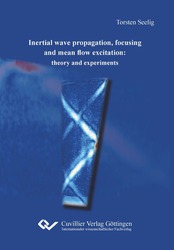| Departments | |
|---|---|
| Book Series (96) |
1378
|
| Nachhaltigkeit |
3
|
| Gesundheitswesen |
1
|
| Humanities |
2364
|
| Natural Sciences |
5406
|
| Mathematics | 229 |
| Informatics | 319 |
| Physics | 980 |
| Chemistry | 1363 |
| Geosciences | 131 |
| Human medicine | 243 |
| Stomatology | 10 |
| Veterinary medicine | 108 |
| Pharmacy | 147 |
| Biology | 835 |
| Biochemistry, molecular biology, gene technology | 121 |
| Biophysics | 25 |
| Domestic and nutritional science | 45 |
| Agricultural science | 1004 |
| Forest science | 201 |
| Horticultural science | 20 |
| Environmental research, ecology and landscape conservation | 148 |
| Engineering |
1793
|
| Common |
98
|
|
Leitlinien Unfallchirurgie
5. Auflage bestellen |
|
Advanced Search
Inertial wave propagation, focusing and mean flow excitation (English shop)
theory and experiments
Torsten Seelig (Author)Preview
Table of Contents, PDF (50 KB)
Extract, PDF (73 KB)
Inertial waves exist in rotating flows and are an ubiquitous phenomena in geophysical and astrophysical flows. The present work studies inertial waves in a homogeneous weakly viscous liquid confined between two coaxial co-rotating cylinders. In a laboratory experiment waves are continuously excited and they propagate due to radial „stratification“ of angular momentum. Inviscid theory describes the formation of wave attractors. Wave energy is reflected several times at the boundaries of the cavity and focused towards geometry dependent attractor paths. Inviscid analytical results will be confirmed by experimental visualisations. Particle image velocimetry measurements will be presented showing particular properties of inertial waves and the existence of zonal/azimuthal mean flows with different origins. Additionally, a simple theoretical model has been developed for a rotating, homogeneous, viscous fluid. The generation of a „mean zonal motion“ due to momentum transport of vertically propagating gravity waves is well known (Plumb and McEwan, J. Atmos. Sci. 35, (1978)). Based on the mathematical analogy it will be shown that in the meridional plane propagating inertial waves can transfer their momentum in the same manner to a sheared mean flow. Even an oscillating mean flow can be driven by inertial waves. The comparison of numerical results originating from numerical computations of two simple analytical model equations and long-time measurements of velocity fields concludes the study.
| ISBN-13 (Hard Copy) | 9783954047932 |
| ISBN-13 (eBook) | 9783736947931 |
| Final Book Format | A5 |
| Language | English |
| Page Number | 130 |
| Edition | 1. Aufl. |
| Publication Place | Göttingen |
| Place of Dissertation | Cottbus |
| Publication Date | 2014-09-08 |
| General Categorization | Dissertation |
| Departments |
Geosciences
Engineering |
| Keywords | geophysical and geological flows, waves in rotating fluids, mean zonal flow, Libration, Stewartsonlayers |








